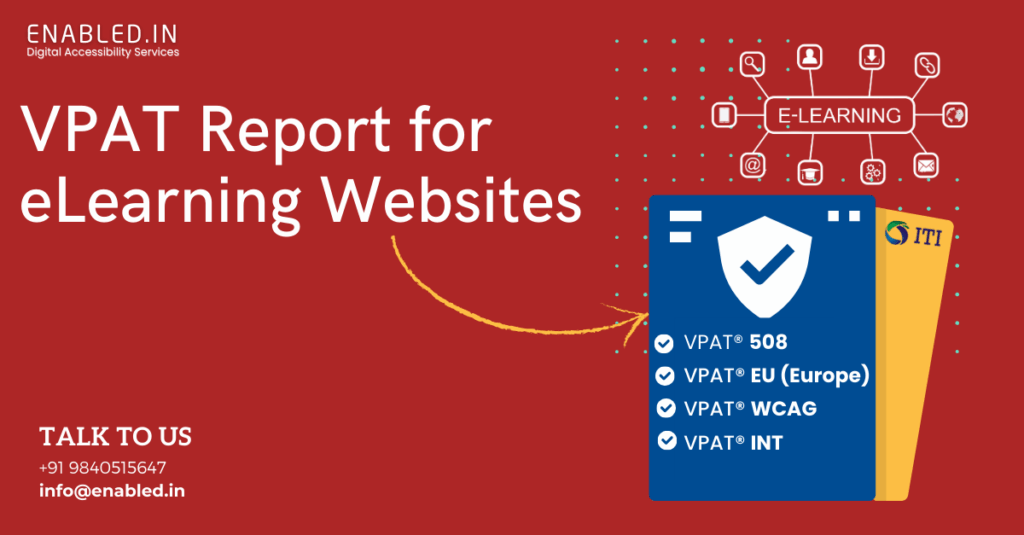VPAT Report for eLearning : Students with disabilities rely on screen readers. They also use keyboard navigation and captions. Other assistive technologies help them access online courses. A Voluntary Product Accessibility Template (VPAT®) records the extent to which your platform meets accessibility standards. These standards include WCAG, Section 508, and EN 301 549.

Without a VPAT, your eLearning platform risks:
- Legal penalties (e.g., ADA lawsuits, Section 508 non-compliance fines).
- Lost business (Schools, governments, and corporations require VPATs before procurement).
- Exclusion of learners (Poor accessibility locks out users with disabilities).
Choose the Right VPAT Version
The latest VPAT 2.4 covers:
- WCAG 2.1/2.2 (Global web accessibility guidelines).
- Revised Section 508 (U.S. federal requirements).
- EN 301 549 (EU accessibility standards).
- INT (International best practices).
Pro Tip: If your platform serves U.S. government agencies, prioritize Section 508 compliance. For EU clients, focus on EN 301 549.
What’s Unique About Accessibility for Online Learning?
eLearning platforms have distinct characteristics that require specific attention to ensure true inclusion:
- Multimedia Content Must “Speak” to Everyone: Video lectures, audio recordings, and animations are staples of online learning. Every video needs accurate, synchronized captions for deaf or hard-of-hearing students. For videos where visual information is critical for understanding but not conveyed by audio, audio descriptions are essential. These descriptions help learners who are blind or have low vision.
- Interactive Learning Needs Inclusive Pathways: Quizzes, simulations, drag-and-drop activities, and virtual labs must be fully operable via keyboard alone. They should not rely solely on a mouse. Instructions for these elements need to be crystal clear. They must be accessible. Feedback on answers must be provided in a format compatible with assistive technologies. Time limits on assessments should also be flexible.
- Content Structure and Navigation Must Be Logical: Think of a book without paragraphs or chapters – it’s unreadable! Online, this translates to using proper HTML heading hierarchies (H1, H2, etc.), clear lists, and descriptive links so screen readers and keyboard users can easily understand and navigate the course material. Consistent, predictable navigation throughout the platform is key.
- Downloadable Documents Need to “Talk”: If your courses include downloadable PDFs, Word documents, or PowerPoint presentations, ensure they are accessible. They need to be properly “tagged” to allow screen readers to understand their structure. Include alternative text for images. Maintain a logical reading order.
- Beyond the Obvious: Cognitive Accessibility: Often overlooked, designing for cognitive accessibility is vital for eLearning. This involves using clear and plain language. Avoid jargon. Break down complex topics into smaller, digestible chunks. Maintain consistent layouts to reduce cognitive load. Providing content in multiple formats (e.g., text, audio, video) can also support diverse learning styles.
Key eLearning-Specific Considerations
- Multimedia Accessibility
- Videos: Captions, audio descriptions, sign language options
- Podcasts/Audio: Transcripts available
- Animations: Pause/stop controls, text alternatives
- Interactive & Assessment Components
- Quizzes: Keyboard-navigable, error suggestions
- Drag-and-drop: ARIA labels for screen readers
- Timed exams: Ability to request extra time
- LMS & Navigation
- Consistent heading structure
- Keyboard-accessible menus
- Text resizing without breaking layout
- Content Structure
- Semantic HTML (proper headings, lists)
- Alt text for diagrams, charts, and infographics
- Readable fonts & color contrast (4.5:1 minimum)
- Third-Party Tools & Plugins
- Ensure PDFs, SCORM packages, and embedded tools (e.g., H5P) are accessible
Test Like a Real Human (Not Just a Bot)
Automated tools catch about 30% – 40% of issues. The rest? You’ll need:
- Keyboard-only navigation (Can you tab through everything? No trapped focus?)
- Screen readers (Try NVDA or VoiceOver—does it make sense or sound like gibberish?)
- Real user testing (If possible, involve people with disabilities—they’ll spot things you’d never think of.)
Final Steps
- Review & Validate: Have an accessibility expert verify the report.
- Publish & Share: Include the VPAT on your website or provide it to clients upon request.
- Update Regularly: Reassess accessibility with major updates.
By following these steps, your eLearning platform can demonstrate a strong commitment to accessibility while meeting legal and ethical obligations.
Get Your VPAT Report for eLearning Today
Don’t let accessibility compliance hold back your eLearning platform. Enabled.in makes the process simple, thorough, and stress-free.
Email us: info@enabled.in
Mobile: +91 9840515647
WhatsApp: Click here to chat on WhatsApp (This is a live link)
You can also learn more about our VPAT and compliance services by visiting our website: enabled.in/vpat-compliance-certification/